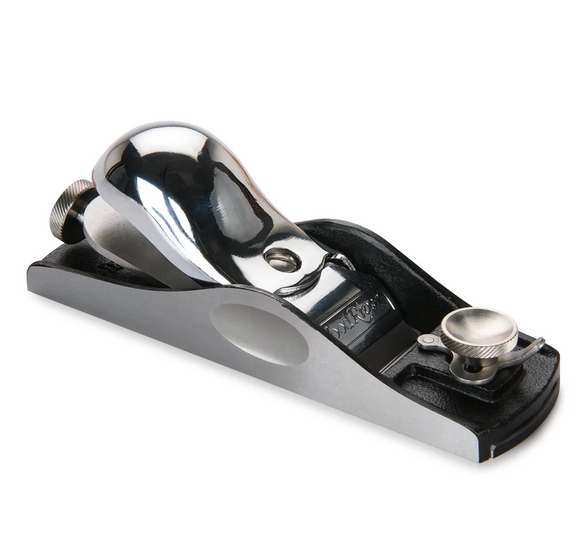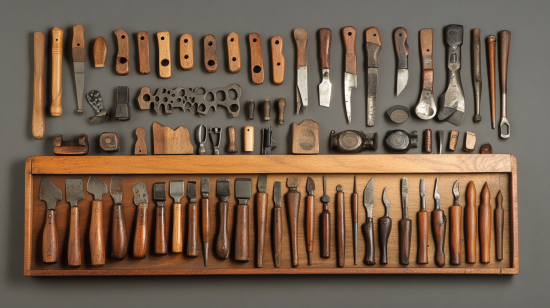
Low Angle Block Hand Plane with Adjustable Mouth
- The WoodRiver® Block Hand Plane is based on the venerable Stanley #65 low angle and #18 standard angle “Knuckle Cap” design, generally considered one of best block plane designs around. With the widely recognized comfortable chrome plated Knuckle Cap, these block planes look like the standard and low angle versions of yester year. Upon closer inspection you’ll notice changes to the base castings which not only strengthen historically weak points of the original design, but also improve the blade bedding area. Improved blade adjustment mechanisms allow for crisp, easy adjustment of the blades using the rear adjustment knob. The adjustable mouth is very smooth to operate and allows fine tuning of the mouth for work ranging from coarse to creating whisper thin shavings. The stress relieved ductile iron castings are precision machined, flat and square. Each plane is outfitted with a high carbon tool steel tool blade, which is hardened to Rc60-64 for maximum edge retention and ground to a 25° bevel. We recommend sharpening the blades prior to use, however they’re impressively sharp right out of the box.
- Features:
- Based on a classic design
- Knuckle style lever cap
- Crisp & easy blade adjustments
- Adjustable mouth
- Made from stress-relieved ductile iron castings
$114.99
Why You Need a Low Angle Block Plane in Your Workshop
As an avid woodworker and carpenter, I know that having the right tools for the job is crucial. A high-quality, versatile low angle block plane is one of those essential tools that no workshop should be without. But with so many options on the market, it can be tricky to know which block plane is right for you.
That’s why I put together this comprehensive guide to walk you through everything you need to know about WoodRiver low angle block planes – from what makes them different to how to use them and maintain them. Whether you’re a beginner looking for your first block plane or a seasoned pro upgrading your toolkit, read on for an in-depth look at why a WoodRiver low angle block plane is a wise investment for your woodworking.
What is a Low Angle Block Plane?
First, let’s start with the basics. A block plane is a small hand plane, typically around 6-7 inches long, designed for trimming and smoothing smaller pieces of wood. The low angle refers to the angle at which the blade sits in relation to the sole of the plane.
WoodRiver low angle block planes have a 12-degree bed angle, which allows you to take very fine shavings without tear-out. The lower angle also gives you better visibility as you work. These characteristics make low angle block planes ideal for working with difficult grain patterns and preventing splintering in end grain.
Key Features and Benefits of WoodRiver Low Angle Block Planes
WoodRiver is a respected brand known for making high-quality hand tools at reasonable prices. Here are some of the stand-out features you get with a WoodRiver low angle block plane:
- Precision machined cast iron body – gives stability and prevents distortion over time.
- Thick 2-1/4″ A2 tool steel blade – holds an edge well and is easy to sharpen.
- Fully adjustable mouth opening – optimize shaving thickness for smooth planing.
- Lever cap with set screw – keeps blade firmly in place during use.
- Large front knob and tote – maximizes control and comfort in hand.
- Pre-flattened precision lapped sole – ensures smooth gliding over wood right out of the box.
- Sealed lever cap and brass fittings – prevents rusting and corrosion.
- Reasonable price point – excellent value for money versus other premium brands.
As you can see, the thoughtful design and durable construction means you get an incredibly versatile and user-friendly block plane that can handle demanding projects while still being affordable.
Step-by-Step Guide to Using a Low Angle Block Plane
One of the joys of using hand planes is that they require skill and practice to master. Here is a quick step-by-step guide to get you started with basic block plane techniques:
- Secure your workpiece – Use clamps or a vise to hold the wood steady as you plane.
- Set the blade depth – Retract the blade completely, then extend it just enough to take a thin shaving.
- Hold the plane properly – Grip the knob with one hand and rest fingers of other hand on top of plane.
- Find the right angle – The plane should be tilted slightly downwards in the direction of the cut.
- Take a few light passes – Let the sharp blade do the work, don’t force the plane.
- Focus pressure on the front – Applying more pressure to the front keeps the cut even.
- Work with the grain – Go along the wood grain for the cleanest cut and least tear-out.
- Lift plane at the end of each pass – Prevent scraping by lifting the plane as you end each stroke.
- Check your progress – Stop periodically to see if you’ve achieved your desired smoothness.
- Carefully resume planing – Once you have the hang of it, you can plane continuously along the board.
It will take some practice to get comfortable using a hand plane, but it’s incredibly satisfying when you achieve that glassy smooth surface!
Ideal Uses for a Low Angle Block Plane
The versatility of a WoodRiver low angle block plane makes it useful for many applications, including:
- Smooth planks, boards, and tabletops
- Trim and fit joints
- Chamfer edges
- Plane end grain
- Shape small moldings
- Fine tune curved surfaces
- Remove glue squeeze-out
The low blade angle gives you superior control for detailed work on difficult woods like teak, rosewood, and ebony that are prone to tear-out. It’s also handy forAny time you need to surgically trim, sculpt, or finesse small pieces, reach for your trusty WoodRiver block plane.
Tips for Buying a WoodRiver Low Angle Block Plane
WoodRiver makes several varieties of low angle block planes ranging in price from $100-150. Here are key factors to consider when choosing one:
- Block length – Standard at 65mm (2.5 inches) but 70mm (3 inch) also available. Go bigger for planing wider surfaces.
- Blade steel type – A2 or O1 tool steel. A2 holds an edge slightly better.
- Mouth adjustments – Look for fully adjustable mouths via lateral lever or Norris adjuster.
- Angle of blade – Some have optional blades at higher angles (e.g. 25 degrees) for tricky grains.
- Accessories – Consider models with extra blades or blade sets for added value.
- Budget – Expect to pay more for higher quality materials and more precision.
I recommend handling the planes in person to evaluate comfort and quality. And be sure to buy from authorized dealers to receive WoodRiver’s lifetime warranty.
Maintaining and Sharpening Your Block Plane
Like any fine cutting tool, a WoodRiver block plane needs some periodic care and sharpening to keep it performing well:
- Clean regularly – Wipe down sole and body, don’t let resin/pitch build up.
- Lubricate – Put a drop of light machine oil on the lever cap and adjustment wheels.
- Check blade tightness – Retighten lever cap if blade feels loose.
- Sharpen when needed – Use stones or diamond plates; 25-30 degree bevel.
- Lap the sole – Use sandpaper on glass to flatten sole as it wears.
- Wax the sole – Apply a light coat of paste wax so wood glides smoothly.
- Protect the blade – Put blade guard on when storing to prevent nicks.
- Adjust the mouth – Tighten mouth for fine cuts, open for coarser cuts.
With proper care, your WoodRiver plane should provide decades of optimal performance. Be sure to check the manufacturer’s instructions as well.
Satisfying Results with a Quality Low Angle Block Plane
As you can see, WoodRiver’s low angle block planes are thoughtfully engineered tools that can tackle a wide range of woodworking tasks. Their sharp blades, robust construction, and fine-tuning capabilities empower you to achieve satisfyingly smooth, tear-out free surfaces. Whether trimming tricky end grain or putting the final touch on a craft project, a WoodRiver block plane will be a go-to item in your shop.
I hope this guide has helped shed some light on the key considerations around choosing and using these handy planes. Let me know if you have any other questions! I’m always happy to talk shop and help fellow woodworkers up their game with quality tools. Cheers and happy planing!



